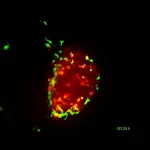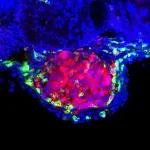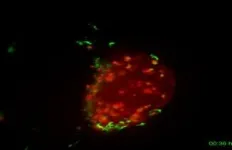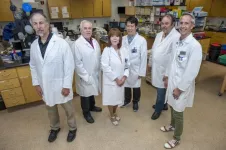(Press-News.org) Using zebrafish “Avatars”, an animal model developed by the Cancer Development and Innate Immune Evasion lab at the Champalimaud Foundation (CF), led by Rita Fior, Mayra Martínez-López – a former PhD student at the lab now working at the Universidad de las Américas in Quito, Ecuador – and colleagues studied the initial steps of the Bacillus Calmette-Guérin (BCG) vaccine’s action on bladder cancer cells. Their results, which are published today (August 1, 2024) in the journal Disease Models and Mechanisms, show that macrophages – the first line of immune cells activated after an infection – literally induce the cancer cells to commit suicide and then rapidly eat away the dead cancer cells.
The idea behind zebrafish Avatars (zAvatars), which are still an experimental, but very promising model, is fairly straightforward: take tumour cells from a cancer patient and inject them into zebrafish embryos. The tumours will then grow inside the embryos, effectively turning them into Avatars of that specific cancer patient. The various treatment options available for that patient can then be tested on the zAvatars – and, in a matter of days rather than several weeks, or even months, that it takes using the traditional testing in mice, it will be possible to determine the best treatment for that patient. The test has been developed and studied with samples from colorectal cancer patient samples (https://fchampalimaud.org/news/clinical-study-shows-zavatar-test-has-high-predictive-power-personalising-colorectal-cancer).
Fior had a new idea for applying the model. “When I joined Rita's lab, as a PhD student” (in 2019), Martínez-López recalls, “we were discussing several projects I could undertake, and Rita mentioned that the BCG vaccine was being used in bladder cancer patients.” Martínez-López remembered getting the BCG against tuberculosis when she was a child in South America, and had later worked on the disease. “But it was the first time I heard of the TB vaccine as a cancer treatment”, she points out. And this immediately caught her attention.
The (hi)story of an idea
The BCG vaccine was first used against TB in the 1920’s and then started to be used as the first cancer immunotherapy around 1976. But decades before that, in the 1890’s, William Coley, a surgeon working at the New York Hospital (now Weill Cornell Medical Center) had already tested a mix of different bacteria, coined “Coley's toxins”, as a cancer immunotherapy!
Coley had noticed that several virtually hopeless cancer patients at the hospital went into seemingly “miraculous” remissions from their cancer when they caught a bacterial infection following the surgery performed to remove their tumours (sterile conditions for surgical procedures were then less than optimal). And his idea was that such recoveries, far from being miraculous, were in fact caused by an immune response of the patients to the infection.
Coley started trying to induce bacterial infections in a number of sarcoma patients and was able to reproduce a few cancer remissions. At the time, though, his method was far from being proven and safe – and meanwhile, other treatment methods were developed, such as radiotherapy – so his research was not pursued. But in recent years, the field of immunotherapy has gained enormous momentum, bringing new and more scientifically robust ways of boosting the immune system to fight cancer (https://fchampalimaud.org/news/check-up-19-cancer-immunotherapy).
“BCG immunotherapy is still rather empirically used” says Martínez-López. “However, since it works for many people, it has become a gold standard treatment. Surprisingly, it is a very effective immunotherapy, even when compared to so many fancy immunotherapies that are being developed.”
The treatment consists of instilling the BCG vaccine directly into the bladder. When the treatment works, the 15-year survival rate for patients with so-called “non-muscle-invasive” (early-stage) bladder cancer is 60% to 70%. However, in 30% to 50% of the cases, bladder tumours are unresponsive to BCG treatment. In these cases, the whole bladder has to be removed.
The macrophages have it
Until now, the way the BCG vaccine works as an immunomodulator to clear bladder tumours was not fully known.
The team’s idea was that immune cells, and in particular macrophages resident in the bladder, were involved. And they were able to determine what happens right after BCG is injected into zebrafish Avatars. To do this, they used so-called light sheet microscopy and confocal imaging, which allowed them to see the macrophages interacting with the tumour cells, at single cell resolution and in real time.
The colourful movies they obtained of the process triggered by the vaccine (in which the macrophages and cancer cells were labelled with different fluorescent dyes) showed that macrophages are heavily recruited to the tumour site upon BCG injection, directly killing human bladder cancer cells via a process of cell suicide (apoptosis) dependent on a substance called tumor necrosis factor (TNF) secreted by macrophages, that acts as a potent signal molecule of the immune system.
They further showed that, when macrophages were depleted in the zAvatar, the anti-tumour effects of the BCG vaccine were completely blocked, thus demonstrating that macrophages are indeed crucial for the initial anti-tumour response.
“What Mayra saw”, says Rita Fior, “was that if you inject BCG, you have a marked increase of the amount of macrophages going into the tumour.” And in the presence of BCG, the immune cells changed color from red to yellow, which meant they expressed TNF.
“Not only did we unravel the mechanisms involved in the first steps of the vaccine’s anti-tumoural action, we also demonstrated that the zebrafish Avatar model is a powerful preclinical tool for drug discovery in oncology”, concludes Martínez-López.
END
Scientists unravel how the BCG vaccine leads to the destruction of bladder cancer cells
2024-08-08
ELSE PRESS RELEASES FROM THIS DATE:
Cleveland Clinic study adds to increasing evidence that sugar substitute erythritol raises cardiovascular risk
2024-08-08
August 8, 2024, Cleveland: New Cleveland Clinic research shows that consuming foods with erythritol, a popular artificial sweetener, increases risk of cardiovascular events such as heart attack and stroke. The findings, from a new intervention study in healthy volunteers, show erythritol made platelets (a type of blood cell) more active, which can raise the risk of blood clots. Sugar (glucose) did not have this effect.
Published in Arteriosclerosis, Thrombosis and Vascular Biology, the research adds to increasing evidence that erythritol may not be as safe as currently ...
Microscopy technique “paves way” for improving understanding of cellular functions
2024-08-08
Scientists have developed a new way of counting labelled proteins in living cells that could become a standard and valuable tool in the field of biomedical research.
This powerful new technique, known as Protein-tag Degree of Labelling (ProDOL), provides a robust and versatile approach for precisely determining labelling efficiencies, the number of proteins that are labelled with fluorescent markers in living cells, in microscopy, a crucial aspect of protein quantification in biological research.
The method ...
Microbes conquer the next extreme environment: Your microwave
2024-08-08
Since the industrial revolution, microbes have successfully colonized one novel type of habitat after another: for example marine oil spills, plastic floating in the oceans, industrial brownfields, and even the interior of the International Space Station.
However, it turns out that one extreme environment harboring a specialized community of highly adapted microbes is much closer to home: inside microwaves. This finding has now been reported for the first time in a study in Frontiers in Microbiology by researchers from Spain. It’s not only important from the perspective of ...
ISTA speeds up academic AI research with NVIDIA accelerated computing
2024-08-08
The Institute of Science and Technology Austria (ISTA) today announced it is investing in a state-of-the-art cluster of over 100 NVIDIA H100 Tensor Core GPUs to enhance its computing infrastructure and scale up machine learning for academic research. The latest-generation GPU cluster specializes in training large language models for generative AI and machine learning. The Institute-funded, multi-million investment helps accelerate AI research in the public sphere at scale and consolidates ISTA as a European computational hotspot.
In the generative artificial intelligence (AI) era, AI research and ...
$11.3 million Program Project grant helping identify causes of vascular disease
2024-08-08
AUGUSTA, Ga. (Aug. 8, 2024) – With a new $11.3 million Program Project grant from the National Institutes of Health, experts from the Vascular Biology Center at the Medical College of Georgia at Augusta University are working to better understand the underlying mechanisms of cardiovascular disease.
“Blood vessels are critical for the transport of oxygen, nutrients, and immune cells and when they don’t function properly it not only impacts the function of the heart, but other organs such as the lung, eye, brain ...
Steady flight of kestrels could help aerial safety soar
2024-08-08
A new joint study by RMIT and the University of Bristol has revealed secrets to the remarkably steady flight of kestrels and could inform future drone designs and flight control strategies.
Watch video: YouTube
Making drones safer and more stable in turbulent conditions, or in cities where wind gusts from tall buildings make flying more difficult, makes applications like parcel delivery, food delivery and environmental monitoring more feasible, more often.
The study conducted in RMIT’s Industrial Wind Tunnel facility – one of the largest of its kind in ...
Molecule restores cognition, memory in Alzheimer’s disease model mice
2024-08-08
In a new study, a molecule identified and synthesized by UCLA Health researchers was shown to restore cognitive functions in mice with symptoms of Alzheimer’s disease by effectively jumpstarting the brain's memory circuitry.
If proven to have similar effects in humans, the candidate compound would be novel among Alzheimer’s disease treatments in its ability to revitalize memory and cognition, study authors said.
“There is really nothing like this on the market or experimentally that ...
C-Path inaugural Global Impact Conference: Pioneering drug development collaborations
2024-08-08
TUCSON, Ariz., August 7, 2024 – Critical Path Institute (C-Path), whose mission is to lead collaborations that accelerate drug development, advancing better treatments for people worldwide, is proud to announce its inaugural C-Path Global Impact Conference (CGIC), taking place from September 9-11, 2024, at the Washington Marriott at Metro Center.
The conference represents a significant expansion of C-Path’s mission, focusing on critical areas of drug development. These areas highlight ...
Skin-to-skin ‘kangaroo care’ found to boost neurodevelopment in preemies
2024-08-08
Skin-to-skin cuddling with a parent has lasting cognitive benefits for premature babies, according to a new Stanford Medicine study. Preemies who received more skin-to-skin contact, also known as kangaroo care, while hospitalized as newborns were less likely to be developmentally delayed at 1 year of age, the study found.
The research, which was published online July 11 in the Journal of Pediatrics, showed that even small increases in the amount of skin-to-skin time made a measurable difference in the babies’ neurologic development during their first year.
“It’s ...
Scientists lay out revolutionary method to warm Mars
2024-08-08
Ever since we learned that the surface of planet Mars is cold and dead, people have wondered if there is a way to make it friendlier to life.
In a groundbreaking study published Aug. 7 in Science Advances, researchers from the University of Chicago, Northwestern University, and the University of Central Florida have proposed a revolutionary approach towards terraforming Mars. This new method, using engineered dust particles released to the atmosphere, could potentially warm the Red Planet by more ...






